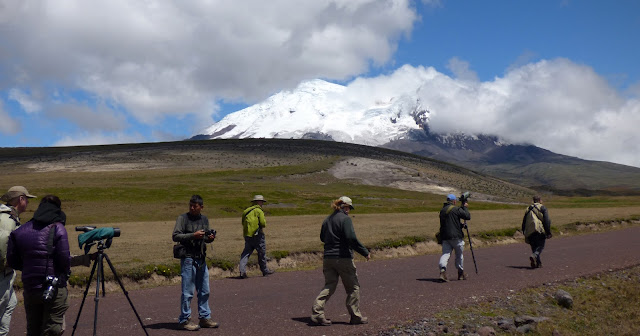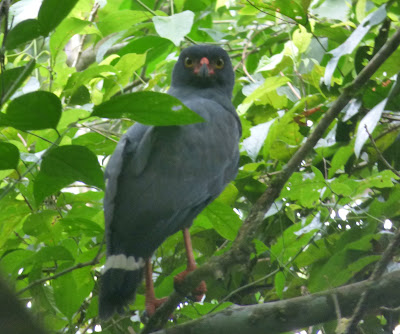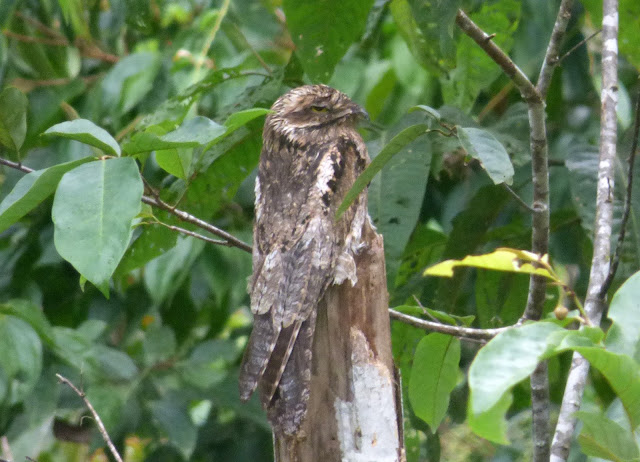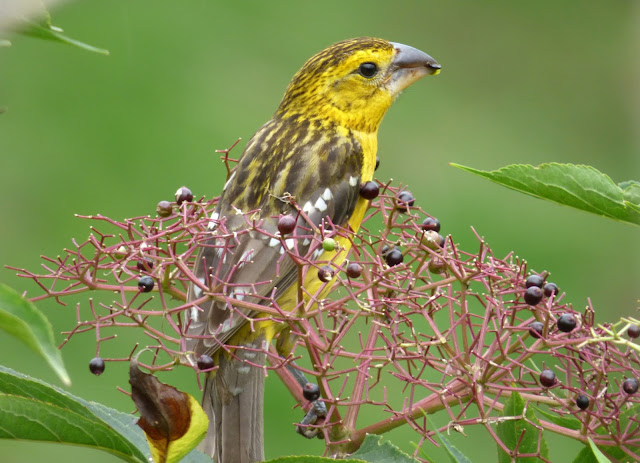Nine brave souls joined Natalia and I for an ornithological
expedition to Ecuador’s Yasuni National Park, a UNESCO Biosphere reserve. Lying
on the equator at the base of the Andes, Yasuni is widely regarded to be the
most biodiverse place on earth and provides habitat for ~600 bird species. Our
base of operations would be the Tiputini Biodiversity Station, a remote
research outpost operated by the University de San Francisco de Quito.
Rather than a standard birding tour with endemic species
targets, we ran this tour as a more holistic ecological learning
experience
with evening lectures paired with related field activities the following
day. For
the purposes of this write-up, the focus is rather strictly on the
birding to suit the intrepid readers of this blog and our sponsoring
organization, the Carolina Bird
Club.
Given that it takes four legs of travel and a full day to
reach Tiputini, we scheduled buffer days on either end in case of any
international travel delays. We used the
first of these days to visit the Paramo ecosystem
of Antisana National Reserve. We explored high altitude grasslands at ~12,000
feet of elevation at the base of the active, glacier-capped Antisana volcano, a
world apart from the Amazon or anything in the Carolinas.
 |
| Our group from the Carolina Bird Club bravely birding at the foot of the Antisana Volcano - ~3400 masl |
On the way into the park we stopped to bird stunted
tree-line forest and were rewarded with birds such as the abundant Black
Flowerpiercer and Spectacled Redstart, a real crowd-pleaser, especially for the
warbler fans among us.
 |
| Black Flowerpiercer - common in the elfin treeline forests near Antisana |
A midmorning stop at the Tambo Condor restaurant gave us
scope views of Andean Condors on the nest, the first of many condors we would
see during the day.
 |
| Andean Condor - we saw several in the Paramo near Antisana |
Among the throngs of Sparkling Violetears mobbing their
feeders, several Giant Hummingbirds could be seen. We even witnessed a few
visits by the spectacular Sword-billed Hummingbird.
 |
| Giant Hummingbird - cooperatively attended feeders at the Tambo Condor restaraunt |
The high grasslands were littered with Carunculated Caracara
and Andean Gull, with the prizes hidden among them being the charming Andean
Lapwing and odd Black-faced Ibis, representing a small population disjunct from
the core range in southern South America.
 |
| Black-faced Ibis - an isolated population lives in the paramo around Antisana |
We birded so intensely, puzzling over
the different color morphs of the well-named Variable Hawk and the subtle
differences between Chestnut-winged and Stout-billed Cinclodes, that by the
time we reached the park visitor’s center, we scarcely had time to hike out to
the laguna to see the Slate-colored Coot, Yellow-billed Pintail, Andean Ruddy
Duck, Andean Teal and Silvery Grebe. We practically had to kick the Plumbeous Sierra-Finches, Tawny
Antpittas and Grass Wrens out of the way to get there.
 |
| Plumbeous Sierra-Finch - common and tame in high altitude grassy areas (and parking lots) |
After a late lunch back at Tambo Condor we tallied up 51
species for the day, a great haul for the relatively depauperate Paramo. Crowd
favorites were the condors, the Sword-billed Hummingbird and the nearly endemic
Ecuadorian Hillstar (Colombia has a habit of nullifying Ecuadorian national
endemics and just a couple handfuls remain), but the ‘best’ bird in terms of
rarity and surprise was a Blue-mantled Thornbill at a stream by the visitor’s
center.
 |
| Blue-mantled Thornbill - a surprising rare find at Antisana |
We returned to our Quito hotel, Café Cultura, just in time
for a lecture about Tiputini Biodiversity Station by its founding director,
Professor Kelly Swing of the University of San Francisco de Quito. He explained
to us how he canoed and camped along the length of the Tiputini River before
selecting the site for the research station in 1994, and how he and other
researchers have been working to catalogue the biodiversity present. Prof. Swing also gave us
a glimpse of the socio-political context of nearby semi-contacted indigenous communities
and insatiable oil extraction.
 |
| Rufous-collared Sparrow - the trashiest of trash birds in Quito and the paramo |
We were up early the next morning to catch our flight to Coca,
a ramshackle Amazonian outpost where we would board a boat to take us meandering
down the Rio Napo. In the blinding late-morning brightness we disembarked at
the Repsol security checkpoint, a gateway to Amazonian wilderness with little of
humanity other than Waorani communities and oil platforms beyond. We rode a
truck two hours down an immaculately maintained gravel service road until we
reached the Tiputini River for one final leg to the station by motorized canoe.
The trip to the Tiputini Biodiversity Station eats up the better part of a day,
but seems to always run flawlessly and provides excellent wildlife viewing
opportunities: a Neotropical River Otter swam by our boat with a fish in its
mouth and of course we saw birds—some familiar Carolinians such as Osprey and the
odd Spotted Sandpiper, but most totally alien, such as King Vulture, the
ubiquitous Drab Water Tyrant, and miraculously, an Orange-breasted Falcon.
 |
| Orange-breasted Falcon - Near-threatened and a rare find for the lowlands (photo by Jeff Maw) |
The latter was perhaps our ‘best’ bird of the
trip as it is known to be a foothill species (and a rare, near-threatened one at
that), reports from the Ecuadorian lowlands had been yet to be documented by
photos, an eBird reviewer would later tell me.
The station has an excellent network of trails, but as we found
on our first morning, searching for birds on a footpath in a primary Amazonian
forest is a recipe for frustration. The canopy birds are all 40 to 50 m overhead and
silhouetted against the sky, while the understory species never run out of
leaves and vine tangles behind which to hide.
 |
| Birding in dense lowland rain forest is hard! |
 |
| Blue-throated Piping-Guan - common thanks to the lack of hunting pressure at Tiputini...we would see several Salvin's Curassows and Spix's Guans as well |
 |
| Green-backed Trogon - formerly known as Amazonian White-tailed Trogon; in this case most of the white tail is missing, probably from repeated entry into a tight nesting cavity |
 |
| Slate-colored Hawk - a forest hunter |
On top of their propensity to skulk out of sight, when one
finally does get a glimpse of the lower strata birds it is rarely sufficient to
confidently identify a woodcreeper or ant-thing from the several pages of vaguely
similar brown/black birds. For a better
handling on those difficult understory species we set up a dozen mist nets,
which revealed the presence of several birds we would not otherwise detect on the
trip.
We caught 13 species including Common Scale-backed Antbird, Amazonian
Barred Woodcreeper, a pair of Blue-crowned Manakins and incredibly, a
Green-backed Trogon.
 |
| Amazonian Barred Woodcreeper |
 |
| His and hers Blue-crowned Manakins - note the female (right) shows a few blue plumes on the head. The local manakin expert explained to us that it is common for older females to show hints of male plumages |
 |
| Green-backed Trogon |
 |
| Peruvian Warbling Antbird (male) - we caught his female partner at the same time |
 |
| Common Scale-backed Antbird - Amazonian birds bite |
 |
| Wedge-billed Woodcreeper - Natalia displays the rarely seen under-wing pattern |
An excellent method for viewing birds at Tiputini is by boat
and we put one the station’s crafts to excellent use.
 |
| On the Tiputini River - Jose was our faithful captain and Mayer (not pictured), our diligent spotter |
It’s not just great for the expected riverside species like
kingfishers…
 |
| Green Kingfisher - we saw four kingfisher species along the Tiputini |
…it also gives an unobstructed view of all forest levels
from the soil to the treetops. From the boat we saw canopy species like
Paradise Tanager and Purple-throated Cotinga as well as terrestrial species
like Undulated Tinamou and Ruddy Quail-Dove.
 |
| A loving pair of Chestnut-fronted Macaws along the Tiputini |
 |
| Common Potoo on 'nest' - we later saw its white egg |
 |
| Great Potoo - the greatest of potoos in my opinion |
 |
| White-eared Jacamar - seen frequently along the Tiputini |
 |
| Ladder-tailed Nightjar - miraculously spotted while roosting in a beached jumble of branches along the banks of the Tiputini |
By boat we travelled the short 20 minutes to a clay lick
where six species of parrots practice geophagy.
What a spectacle!
 |
| Clay lick chaos - pictured are: Mealy Parrot, Blue-headed Parrot, Orange-cheeked Parrot, Dusky-headed Parakeet |
We also used the boat to visit an oxbow lake where the
bizarre Hoatzin breeds by the dozens.
 |
| a pair of Hoatzin - in case you were still on the fence about whether birds are dinosaurs |
 |
| Hoatzin nestling |
A couple unexpected gems here were a Rufescent Tiger-Heron
on a nest and one of my long sought-after species, Agami Heron.
 |
| Rufescent Tiger-Heron on nest |
 |
| Agami Heron! |
For better viewing of the birds flitting around high
overhead we employed the station’s sturdy 50 m high canopy tower, which sits
within the crown of an emergent ceiba tree, giving a commanding view over a sea
of pristine climax forest. Indeed the
feeling up there is reminiscent of pelagic birding, except with the platform
mercifully still and the blue cresting waves replaced the green humps of tree
tops. Instead of shearwaters, petrels and storm-petrels there are toucans,
macaws and gaudy flocks of tanagers.
Unfortunately I was bed-ridden with flu on this crucial morning,
so missed out on some amazing birding and photography. So it goes. Reports of
crippling views of Black-bellied Cuckoo and Golden-collared Toucanet were
enough to make me jealous.
 |
| Black-bellied Cuckoo - photographed not from the canopy tower |
At Tiputini we racked up species, but inevitiably, in a
place with such a long list of rare and local birds we left a lot on the table.
On our last day we added 20+ new species to the trip list including great spot lit
looks at Spectacled Owl and Crested Owl right over our cabins. We were nowhere
close to hitting diminishing returns and had we stayed a 7th day, I’m
sure we could have added another ~20 more.
 |
| Carolina Bird Club group at the entrance to Tiputini Biodiversity Station |
Crowd favorites for Tiputini were Golden-collared Toucanet, Agami
Heron, Golden-headed Manakin and Pavonine Quetzal.
 |
| Golden Headed Manakin |
 |
| Pavonine Quetzal |
On the trek back we out we added one new trip bird:
Broad-winged Hawk, a rare bird for the amazon and a lifer for nobody in our
group except our 72-year-old guide!
 |
| Broad-winged Hawk - a rare find for the lowlands and a lifer for Mayer, our 72-year-old guide |
For our final day of the tour we dropped down the western
slope of the Andes to visit one of the most famous birding sites in all of
South America—Refugio Paz de las Aves. Here outside the rural town of
Nanegalito, Angel Paz invented and perfected the art of worm-feeding antpittas.
 |
| Happy 51st birthday Angel! |
We
started the day in the pre-dawn gloom at a lek of Ecuador’s national bird, the
Andean Cock-of-the-rock. Several blood-red males danced and sang their ethereal
warblings. But soon Angel whisked us off on a mad dash to the various Antpitta
feeding areas. They would only come out in the morning and were a bit spread
out, so time was tight. Thus we had to don blinders and ignore several mixed
species flocks, no doubt packed with additional trip birds and lifers, but it
was a worthy sacrifice as Angel delivered.
 |
| 'Angelita,' Chestnut-crowned Antpitta - the least rare, and arguably, the prettiest of Refugio Paz de las Aves' Antpittas |
When I had been to visit Angel before, only Maria, the Giant
Antpitta had made an appearance. But on this day—incidentally, it was his 51st
birthday—Angel procured for us a sweep of 5 of 5 possible antpittas: Maria, the
Giant, endangered and endemic to the Choco bioregion; Willy, the Yellow-breasted;
Angelita, the Chestnut-crowned; Shakira, the petite Ochre-breasted with her
swinging hips; and Susan, the Moustached, vulnerable and endemic to the Choco.
 |
| 'Shakira,' the hip-swinging Ochre-breasted Antpitta |
The hummingbird and banana feeders with gems like Velvet-purple Coronet and
Purple-bibbed Whitetip were icing on the cake. Choco endemic Dark-backed
Wood-Quail, Black-chinned Mountain-Tanager, Toucan Barbet and Plate-billed Mountain-Toucan
(featured on the cover of our field guide) were cherries on the frosting.
 |
| Blue-winged Mountain-Tanager - drawn close by bananas left out by Angel |
 |
| Dusky-capped Flycatcher - my favorite Myiarchus rudely interrupted breakfast |
 |
| Golden Grosbeak (female) - nice view from breakfast at Refugio Paz de las Aves |
By the time we finished a delicious breakfast, it was
afternoon and we were hopelessly behind schedule. We had lunch soon-after
overlooking another array of hummingbird and banana feeders that provided dozens
of hummingbirds and tanagers included White-whiskered Hermit, Western Emerald
and Silver-throated Tanager.
 |
| The best way to eat lunch: with a pile of bananas and 15 hummingbird feeders |
We took a short walk along a stream laden with
White-capped Dipper to find a an active Cock-of-the-rock nest under a bridge.
We took the old scenic highway back toward Quito and as we
climbed up the Andes stopped to ogle a Crimson-bellied Mountain-Tanager that
flew across the road before we reached the charming town of Nono. Here we
sipped tea spiked with homebrew while ticking some final trip birds such as Mountain
Velvet-breast, Collared Inca and Rufous-chested Tanager.
After the final accounting, we logged a mind-boggling
381 bird species in just 10 days in the field, enough to smash the North
Carolina big year record. In reality, omitting heard-only birds and those seen by
others in the group, each individual participant probably ticked 300-330. I
usually make a point of ignoring non-birds on this blog, but in the case of
this trip, that seems a bit criminal, as we saw 16 large mammal species
including 9 types of monkeys at Tiputini. The myriad snakes, turtles, lizards,
bats and kaleidoscope of butterflies, will go otherwise unmentioned.
Apart from Natalia and I getting sick (a trip tradition),
everything, the birds, the weather, the group seemed to coalesce flawlessly.
All left Quito with memories for a lifetime and plenty of stories to tell at
holiday gatherings and Christmas Bird Count dinners.










































